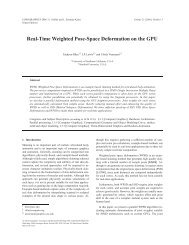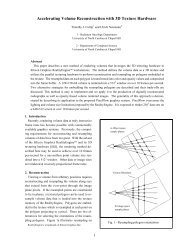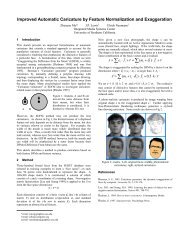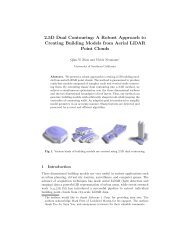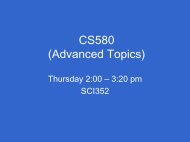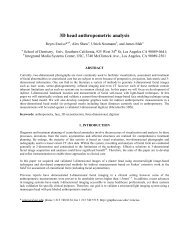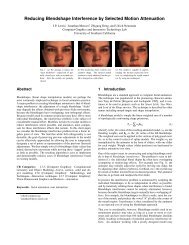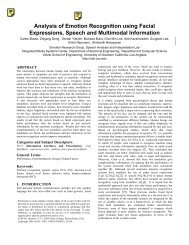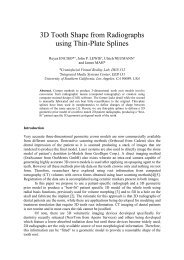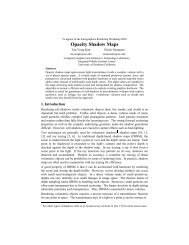Human Hand Modeling from Surface Anatomy - University of ...
Human Hand Modeling from Surface Anatomy - University of ...
Human Hand Modeling from Surface Anatomy - University of ...
You also want an ePaper? Increase the reach of your titles
YUMPU automatically turns print PDFs into web optimized ePapers that Google loves.
ACM SIGGRAPH Symposium on Interactive 3D Graphics and Games I3D 2006<br />
Figure 6: <strong>Hand</strong> clone results: (a) picture <strong>of</strong> source hand, (b) clone<br />
hand model with texture mapping, (c) skin geometry <strong>of</strong> generic<br />
hand model, (d) deformed skin geometry <strong>of</strong> clone hand, (e) joint<br />
skeleton <strong>of</strong> generic hand model (each circle is a joint location), (f)<br />
modified joint skeleton <strong>of</strong> clone hand<br />
<strong>of</strong> distal palmar crease Ha and the start point <strong>of</strong> proximal palmar<br />
crease Hb [Figure 9(c) (Color Plate)]. Within each segment Si, we<br />
can arrange MCP joints at approximately one-third <strong>of</strong> Si <strong>from</strong> the<br />
line H with the analysis <strong>of</strong> surface anatomy in section 2.<br />
The two highest curvature points, Wa and Wb <strong>of</strong> the ulnar and radial<br />
side <strong>of</strong> contour curve in wrist area, can represent the anatomical<br />
boundary between the wrist bones (ulna and radius) and carpal<br />
bones. These two points, Wa and Wb, are simply calculated by the<br />
highest curvature points <strong>of</strong> contour within the wrist region, which is<br />
below the MCP joint <strong>of</strong> the thumb. The wrist joint can be estimated<br />
by mid-position <strong>of</strong> Wa and Wb [Figure 9(c) (Color Plate)].<br />
We have extracted every mechanical joint except the thumb CMC<br />
joint with analysis <strong>of</strong> surface anatomy. However, since the CMC<br />
joint <strong>of</strong> the thumb has relatively complex movements compared<br />
with other joints, and 2D surface anatomy cannot give enough information,<br />
estimating the CMC joint is very difficult. We position<br />
the thumb CMC joint based on the following anatomical analysis.<br />
First, the metacarpal bone <strong>of</strong> the thumb is parallel to line M and<br />
starts <strong>from</strong> the MCP joint <strong>of</strong> thumb [Figure 9(c) (Color Plate)]. Line<br />
M can be calculated by least square line fitting on the middle part <strong>of</strong><br />
contour curve segment between the highest curvature point Wb and<br />
the MCP joint. The axis <strong>of</strong> the radius bone is parallel to the medial<br />
axis <strong>of</strong> wrist and passes point Wb. Since the anatomical CMC joint<br />
6<br />
is located on the end <strong>of</strong> the metacarpal bone, the mechanical CMC<br />
joint can be on the intersection point between the axis <strong>of</strong> the radius<br />
bone and metacarpal bone.<br />
From the extracted 2D joints, we can modify the joint skeleton <strong>of</strong><br />
the 3D generic hand. Since the origin and the y-axis <strong>of</strong> the generic<br />
hand model is determined by the wrist joint and the vector <strong>from</strong><br />
wrist joint to middle finger tip, respectively, a simple affine transformation<br />
matrix Ms can transfer the source hand coordinate to the<br />
generic hand coordinate. For accurate scaling, we measured hand<br />
length <strong>from</strong> the wrist to the middle finger tip when taking the hand<br />
picture. The generated joint skeleton model for clone hand is shown<br />
in Figure 6(f).<br />
5.2 Skin modeling<br />
In addition to the joints, the contour <strong>of</strong> the hand is a unique and<br />
important feature <strong>of</strong> a person’s hand. Curve segment matching can<br />
allow automatic feature correspondence between the source hand<br />
and generic hand. From the corresponding features we can warp<br />
entire geometry using scattered data interpolation based on the radial<br />
basis functions (RBFs).<br />
5.2.1 Curve segment matching<br />
From the joint modeling process in section 5.1, we can obtain a<br />
joint skeleton model with 21 corresponding features. The skin vertices<br />
related to the joint skeleton can be used as the corresponding<br />
feature between the generic and source hand. In addition to these<br />
21 features, contour <strong>of</strong> the hand provides good feature correspondences,<br />
since the source hand picture is also a skin texture image<br />
taken in the specific viewing direction and pose [Figure 6(a)].<br />
When we deform the hand skin, the mesh between creases should<br />
be continuous. The contour <strong>of</strong> the hand can be divided into 30<br />
curve segments Gi = {G1,...,G30} based on the hand creases and<br />
geometry <strong>from</strong> the analysis <strong>of</strong> hand surface anatomy [Figure 1(c)];<br />
each Gi consists <strong>of</strong> ordered 3D vertices Vij = {Vi1,...,Vin} along<br />
the curve segment Gi, where n is chosen to represent curve segment<br />
geometry sufficiently and Gi are carefully extracted when making a<br />
generic hand model using the related joint skeleton.<br />
Figure 7: Curve segment matching example: (a) Curve matching<br />
example <strong>of</strong> curve segment S2(s2,e2): s2 is on the intersection between<br />
contour and the palmar distal crease <strong>of</strong> little finger, and the<br />
e2 is on the intersection between contour and the PIP crease <strong>of</strong> little<br />
finger, (b) Curve segment 2 in generic hand model<br />
Every Gi is transformed to the source hand coordinate using the<br />
inverse matrix <strong>of</strong> Ms in section 5.1. The transformed curve segments<br />
are G ′ i = {G′ 1 ,...,G′ 30 } and each segment G′ i consists <strong>of</strong> transformed<br />
2D points V ′ ij . With curve segment matching based on the<br />
arc length, we can find corresponding feature <strong>of</strong> V ′ ij in the source<br />
hand image. Our algorithm can accumulate small errors within its<br />
traversing step but it shows acceptable results in our experiment.



